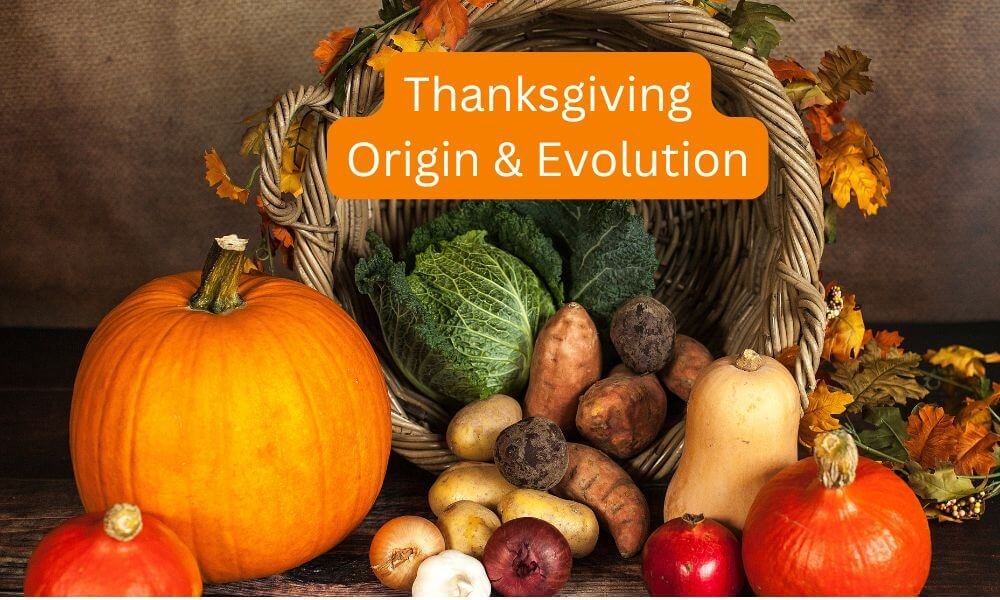The Origin, Evolution, and Current Trends of Thanksgiving
Thanksgiving is a widely celebrated holiday in the United States and Canada, observed as a day for giving thanks, sharing meals, and spending time with family and friends.
However, its origins go beyond the familiar stories of Pilgrims and Native Americans.
The history of Thanksgiving is rich and complex, evolving over centuries and incorporating various cultural and religious influences.
Today, it remains one of the most cherished holidays in North America, with modern trends that reflect changing societal values and practices.
The Origins of Thanksgiving
While the most common narrative of Thanksgiving traces its roots to the early 17th century, when Pilgrims and Native Americans celebrated a harvest feast, the holiday’s origins are far more complex and layered.
Thanksgiving can be understood as a blend of harvest festivals, religious observances, and colonial histories.
Pre-Colonial Traditions
Before the arrival of European settlers in North America, many indigenous cultures held seasonal festivals to celebrate the harvest and give thanks to the earth for its bounty.
Native American tribes, such as the Wampanoag, Iroquois, and other Eastern Woodland peoples, held annual feasts to honor the harvest and show gratitude to their deities for providing food.
These celebrations often involved communal meals, dancing, and rituals, similar to the idea of giving thanks for a successful harvest, a theme that is central to the modern Thanksgiving holiday.
The First Thanksgiving (1621)
The most iconic origin story of Thanksgiving is the 1621 feast between the Pilgrims and the Wampanoag in Plymouth, Massachusetts.
The Pilgrims, English Puritans who fled religious persecution in Europe, arrived in Plymouth, Massachusetts, aboard the Mayflower in 1620.
After a brutal winter in which nearly half of the colonists perished, they were aided by the Wampanoag people, particularly a man named Tisquantum (better known as Squanto). He taught the Pilgrims how to cultivate corn, fish, and survive in their new environment.
In the autumn of 1621, after a successful harvest, the Pilgrims and the Wampanoag gathered for a three-day feast to celebrate. This event, later romanticized as the “First Thanksgiving,” was not a formal holiday at the time, but rather a simple harvest celebration—a common practice among both European settlers and indigenous tribes.
Religious Thanksgiving Observances
Thanksgiving as a religious observance also has roots in European traditions.
English Puritans and other religious groups would often hold days of fasting and prayer during times of hardship and days of thanksgiving during times of prosperity and blessings.
These days of thanksgiving were not tied to a specific date but were declared by local church leaders as needed.
In this sense, the Pilgrims’ celebration in 1621 was in line with their religious practice of giving thanks to God for the harvest, though it was not initially viewed as an annual event.
The Evolution of Thanksgiving in America
Thanksgiving as we know it today did not become a formalized national holiday until centuries after the Pilgrims’ feast. Its evolution was shaped by various social, political, and religious factors over time.
Thanksgiving Proclamations and Early Celebrations
In the decades following the 1621 event, sporadic Thanksgiving celebrations were held in different colonies, usually declared by governors or religious leaders to mark moments of prosperity, military victories, or the end of droughts. These celebrations were not annual and were often more solemn than festive.
One of the earliest formal proclamations of a day of thanksgiving came in 1789, when George Washington, the first President of the United States, declared a National Day of Thanksgiving to give thanks for the end of the Revolutionary War and the ratification of the U.S. Constitution.
In his proclamation, Washington called for a day of prayer and gratitude for the blessings of peace and prosperity in the young nation. However, this was not yet an annual tradition, and subsequent presidents did not always observe the holiday.
The Influence of Sarah Josepha Hale
One of the most significant figures in the creation of Thanksgiving as a national holiday was Sarah Josepha Hale, a 19th-century writer and editor.
She is often referred to as the Mother of Thanksgiving. Hale began a campaign in the 1840s to establish Thanksgiving as a national holiday.
She believed that a National Day of Gratitude would help unify the country during a time of growing sectional tensions.
For nearly 20 years, Hale wrote letters to politicians, governors, and presidents advocating for Thanksgiving, until she finally succeeded in 1863 when President Abraham Lincoln issued a proclamation establishing the last Thursday in November as a National Day of Thanksgiving.
Lincoln’s decision came during the height of the Civil War, and he hoped the holiday would foster a sense of unity and healing in a divided nation.
In his proclamation, Lincoln called on Americans to give thanks for the nation’s blessings, even during war.
Establishment as a National Holiday
Following Lincoln’s proclamation, Thanksgiving was celebrated annually on the last Thursday in November.
In 1941, President Franklin D. Roosevelt signed a bill officially fixing the date of Thanksgiving as the fourth Thursday in November.
Roosevelt had initially tried to move the holiday earlier to extend the Christmas shopping season during the Great Depression, but this decision met with public resistance and was soon reversed.
By the mid-20th century, Thanksgiving had solidified as a central American tradition, marked by family gatherings, large meals, and national gratitude.
Thanksgiving Traditions and Symbols
As Thanksgiving evolved into a national holiday, various traditions and symbols became associated with it.
Many of these traditions are rooted in both the original harvest festivals and the cultural practices that developed in 19th and 20th-century America.
The Thanksgiving Meal
At the heart of Thanksgiving is the traditional meal, which has become synonymous with the holiday.
While there is little detailed historical record of the exact food served at the 1621 feast, today’s Thanksgiving table typically features:
- Turkey: Often referred to as “Turkey Day,” Thanksgiving is famously associated with roasted turkey, though the Pilgrims may have eaten other wild fowl like ducks and geese. Turkey became the centerpiece of the meal by the 19th century due to its availability and size, making it ideal for feeding large gatherings.
- Stuffing and Gravy: Bread stuffing and gravy are common accompaniments to the turkey, reflecting old-world European culinary traditions.
- Cranberry Sauce: Cranberries are native to North America, and although they were likely present at the original feast in some form, the sweetened cranberry sauce served today is a more modern addition.
- Pumpkin Pie: While pumpkins and other squash were likely part of the original Thanksgiving menu, pumpkin pie became a Thanksgiving staple in the 19th century, symbolizing the autumn harvest.
- Other Dishes: Regional variations of the Thanksgiving meal include mashed potatoes, sweet potatoes, green bean casserole, cornbread, and pecan pie.
Parades and Football
By the 20th century, Thanksgiving had expanded beyond the meal to include two major American pastimes: parades and football.
- The Macy’s Thanksgiving Day Parade: First held in 1924, the Macy’s Thanksgiving Day Parade in New York City has become an iconic part of the holiday. Featuring giant balloons, marching bands, and performances, the parade is televised nationally and watched by millions of Americans every year.
The event marks the unofficial start of the Christmas season and is famous for its elaborate floats and performances by celebrities and Broadway casts.
- Thanksgiving Football: Football on Thanksgiving has become a beloved tradition. The first Thanksgiving football game was played in 1876, shortly after the sport was developed.
Today, the NFL hosts annual Thanksgiving games, and many families gather to watch football after their meal. High school and college football games are also common on Thanksgiving, with many communities organizing “Turkey Bowls.”
Giving Thanks and Charity
While the holiday has become heavily commercialized, the central theme of Thanksgiving remains gratitude.
Many families take a moment during their Thanksgiving meal to reflect on what they are thankful for, whether through prayer or a group discussion.
Additionally, Thanksgiving is a time when many people engage in acts of charity, such as volunteering at food banks, participating in community meals for the homeless, or donating to charitable causes.
Current Trends in Thanksgiving
Thanksgiving has continued to evolve in the 21st century, adapting to changing social values, economic realities, and technological advancements.
While traditional customs remain strong, modern trends reflect a broader shift in how people observe the holiday.
Diversity and Inclusivity
As America becomes more multicultural, Thanksgiving has adapted to reflect diverse cultural traditions.
Many immigrant families in the U.S. celebrate Thanksgiving alongside their own customs, blending traditional American foods with dishes from their cultural backgrounds.
For example, Mexican-American families might serve tamales alongside turkey, while Asian-American families might incorporate dishes like spring rolls or fried rice into their Thanksgiving meals.
In addition, Thanksgiving is increasingly seen as an opportunity to reflect on the holiday’s complex history, particularly regarding the relationship between European settlers and Native Americans.
Some people choose to use Thanksgiving as a time to acknowledge and honor Native American history and culture, while others participate in events like the National Day of Mourning held by indigenous groups in Plymouth, Massachusetts, as a way to remember the losses suffered by Native peoples during and after European colonization.
Friendsgiving
A more recent trend is Friendsgiving, an informal celebration typically held in the days leading up to Thanksgiving or on the holiday itself.
Friendsgiving is a gathering of friends (rather than family) who come together to share a meal and give thanks.
It has become especially popular among younger generations and those who live far from family, providing an opportunity to celebrate the holiday with their chosen family of friends.
Health-Conscious and Sustainable Practices
As awareness of health and environmental issues grows, many people are choosing to celebrate Thanksgiving in more health-conscious and sustainable ways.
This includes preparing lighter, plant-based versions of traditional Thanksgiving dishes, such as tofurkey (a tofu-based turkey alternative) or meals focused on seasonal vegetables.
Some families also opt for locally sourced or organic ingredients, reflecting a growing movement toward sustainable eating.
In addition, reducing food waste has become a key focus for many Thanksgiving celebrations. People are increasingly mindful of the amount of food they prepare, with many families making an effort to repurpose leftovers or donate excess food to those in need.
Thanksgiving and Technology
In recent years, technology has played an increasing role in how people celebrate Thanksgiving.
Social media platforms like Instagram and Pinterest are filled with Thanksgiving recipes, décor ideas, and tips for hosting.
Family members who are unable to be together in person often connect via video calls, especially during events like the COVID-19 pandemic, when virtual gatherings became a necessity.
Online shopping has also transformed Thanksgiving. Black Friday, the day after Thanksgiving, marks the start of the holiday shopping season, and with the rise of e-commerce, many retailers have extended their sales online.
Some retailers now even start their sales on Thanksgiving Day itself, though this practice has sparked debate about consumerism encroaching on family time.
Conclusion
Thanksgiving has evolved from a small harvest festival and religious observance into a national holiday centered around gratitude, family, and food.
Its history is shaped by cultural exchanges, political proclamations, and religious influences, while its modern form reflects the diversity and complexity of American society.
As new trends like Friendsgiving, sustainability, and technology continue to shape the way people celebrate, Thanksgiving remains a dynamic and meaningful holiday that brings people together to give thanks for the blessings in their lives.


